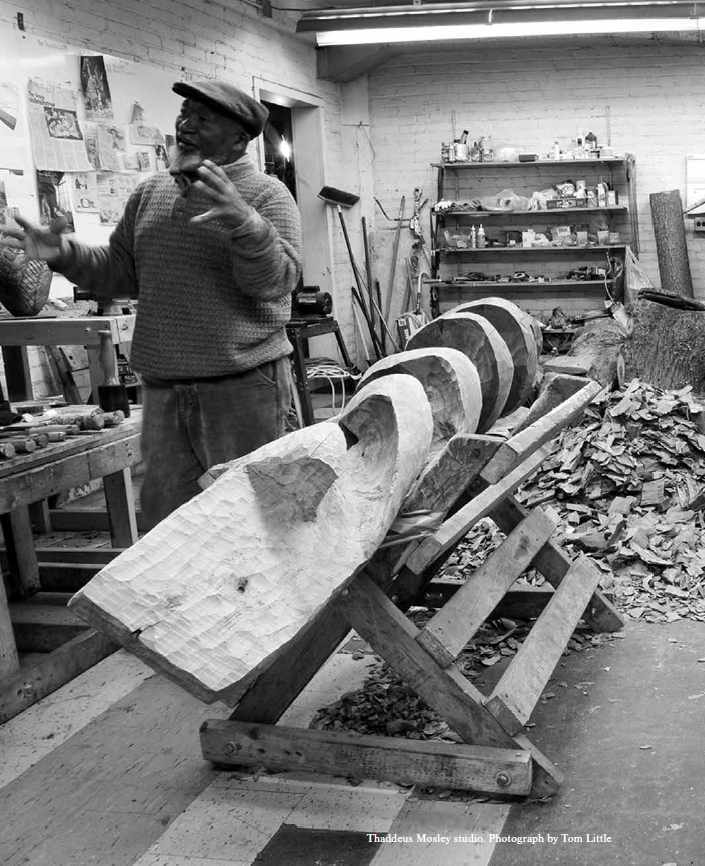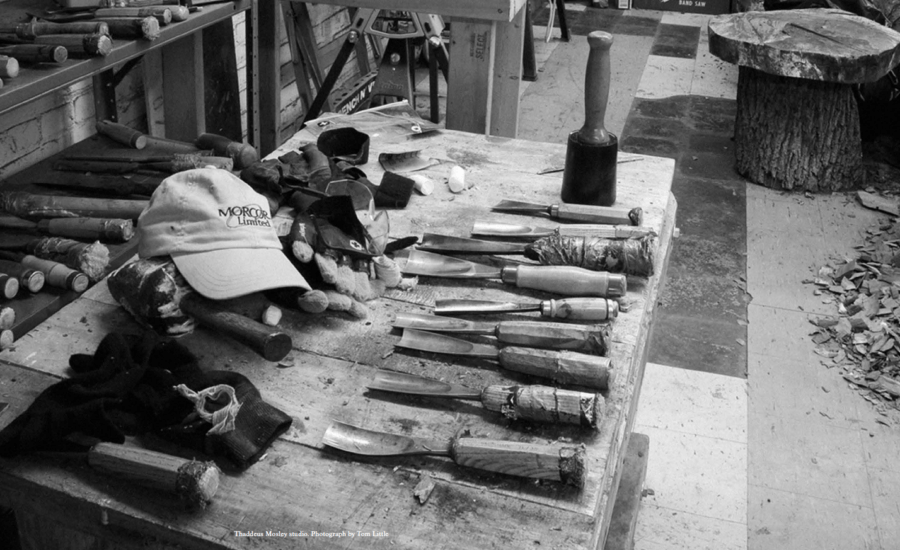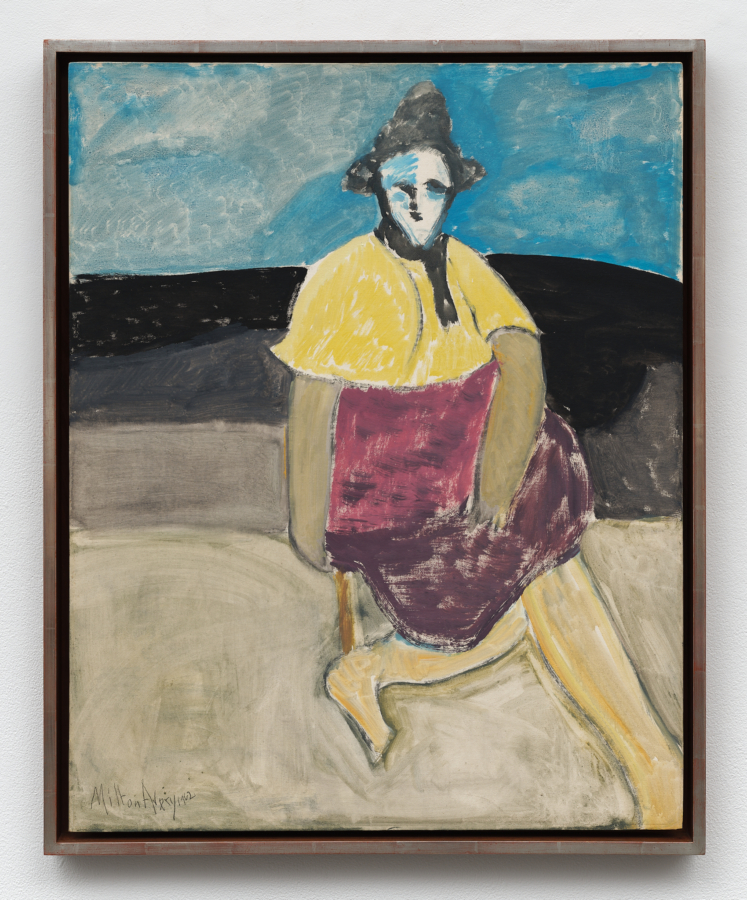February 14, 2020
Thaddeus Mosley, published by Karma, New York, 2020.
Download as PDF
Thaddeus Mosley is available here

Art comes from all around, not just from where we stand to make or see it. Some art makes us see that there is more to it than we can see, as part of our observation. Sculpture does this. When we look at some art, we can see history; time is one of its properties, like shape or color. Sometimes, we are made to follow time as it works with the object. Thaddeus Mosley creates sculptures out of this dynamic. Wood lives.
He articulates what we see and suggests what we can’t see. His forms in wood demonstrate that what we see immediately is only part of what we can see finally. His works are abstractions of actual shapes in time: the limbs of a tree, a chevron, a bird—all at once in varying scale. He makes present a negative space, articulated into the sculpture much as Henry Moore does. He often creates negative forms with weight. Think of the floating holes of air behind a Barbara Hepworth, to which she gives a background sky with her accents of oxidation. Then watch how Mosley uses his skill at chiseling. He is the premier sculptor in natural wood in this country.
To understand the sculptures, we must first recall our understanding of the material. In many ways we see a tree as having no motion. It is never anywhere other than where it is. We not only see it as stable, even unmovable, but we also feel the wood as something we can hold on to, that will hold us. A seat, a chair, a post to lean on.
The fact is, a tree moves, only at speeds that are not perceptible to the time of our eyes. It reaches for food, it gets a drink, moves into the warmth of sunlight too slowly for us to notice—except in the calligraphy of its grain. We are in awe of its movement in a strong wind, for instance: the control of its balance through structure and flexibility into a choreography that is as instructive as any war dance or balletic tale like Stravinsky’s “Rite.” And should the tree have a limb ripped off, we are, after a while again, awed to see it knot over the absence into a kind of decoration. Besides mass, volume, and scale, these are the lines, colors, and shapes through which Thad Mosley sculpts his visions in three dimensions.
What the wood retains, he extends into fuller discussion: into the life of shapes, of forms, into structural lines of movement and balance. Wood is his material, but he is not mimetically recreating a tree story, not creating a landscape painting with all its art history references. Mosley’s work is a discussion between the artist and his material. He is fluent in and deeply respectful of its language, living nature, historical tales, and sense of movement and decoration.
In any art, a line from here to there articulates how long, how far, how wide, how much—space. In Mosley’s material, the wood is lined. The grain of the wood is a drawn line of living laid down in the body of the material. The line is rarely straight, neither in grain nor shape. A sequence of shapes draws a line of movement. It can be direction as much as a line of transformation—growth, or diminution.
Mosley’s seemingly simple sculpture, Phoenix II (2015), is a tour de force of weight in space. It is made up of three parts, one of them sculpted from a different section of wood. Each part is different in character. Taking the basic columnar statement of height, one is a base—abstract, clear and clean as geometry; the next is the column— historical, a record of its source with its intact natural forms; the third is the capital—articulated, carved. It is the intellectual, the effort, the discussion with the material on display.
The image is vertical, yes; but it resembles something perched. There is an off-balance element that points to a controlled construction. We see a dynamism in the third section that acts against or develops out of the stack-up of weight, which is supported by a heavy, static base outlined by the other two sections. It acts: it appears alive, as if incarnated. The carved and chiseled shape of this section elaborates and stylizes the forms wood takes in its own lifetime. This transformation perches on the material of its origin, in flamboyant defiance of nature. The mythological image of the phoenix simply hints at a more complex discussion of what is spatially occurring in this Mosley work.
Mosley appears very African in his spiritual sense of materials as having a sacred and natural life of their own. In Masked Extension (2011), we see the three-part sculpture of a vertical cone with a changed direction—a seemingly pure abstraction, an awkwardly clean geometry with no outward dialectical subject. But notice where the articulation, the carving artistry occurs. It occurs in that transforming middle—become top—section. The geometry of this part of the sculpture is a cross section of the whole, but it is enlarged, and is placed counter to the originating direction of the cone.
The top, capital, primary section of this sculpture seems to have been the elaborate middle out of which the cone now culminates in a new directional point. This top section is the face of the sculpture—the place of development, of movement. With its big fleshy round head, it is the fulcrum in the distribution of weight throughout the sculpture. The re-directed point then becomes the changed direction of the geometric ideas.
Mosley’s curiosity and ability to sniff out ideas, to change direction, to solve problems such as weight in space have sculpted a mask of the art which his mind wears. Its voice—its discussions, narratives, lessons—is spoken in mass, volume, and scale; in tone, shape, form, and surface. This sculptural self-portrait is also a very telling graphic of how amazingly far the African mask tradition has evolved in Mosley’s hands.
Comparing the spartan erudition of Masked Extension to the boldly frank sculpture, Diver (2014), we take up again the subject of wood. Here, though, we are confronted by the stark wood as planks. They are outstretched as workman-like or buttressing arms, but they are also a set of wings. A serendipitous natural growth, only slightly chisel enhanced, appears (if seen below the two raised arms) as two breasts anatomically lifted in place within the composition of the sculpture’s structural and surface effects. Mosley’s eye for making is well matched by his eye for seeing.
Mosley’s art does not depend on a hard re-statement or quotation of art history for the impact of its ideas. His references are mostly natural, vernacular, graphically universal in their suggestiveness. To any eye unclouded by contemporary art-speak, he can be seen as one of the most original thinkers in practice. I, however, still think of Mosley’s artistic lineage as African, and regard him as a most original American thinker.
One of the few instances in which he has clearly outlined a reference is the work in walnut, Repetitive Reference (2015). Mosley is on record as saying this work is based on Dogon sculpture. The reference is to the chiwara, an antelope figure mounted on the back of another antelope. It is a traditional tribal symbol of fertility, not only human, but agricultural animal, universal fertility. It is also the symbol of family, of lineage. The spatial projection of this piece compels the observer to stand back, as well as a presence of one who commands a distance of respect.
What is dismissively called “tribal art” has the distinctive characteristic of creating a vitality, a perceptible exchange-interchange of presence. Much of Mosley’s work does this. It requires a good size room not because it is large, but because it projects its presence. A Mosley sculpture calls the environment to action, it makes you feel the room. You are supposed to feel that the sculpture is there, interacting with space. If someone on the street suddenly points up, all eyes in the crowd look to the sky. This sculpture makes you look for something in yourself. It goes beyond the creation of negative space. Added to the line of direction in which the horns of this piece are pointing, there are carved lines, waves of texture written into the pointing section’s form. Even though that form is the axial section of the sculpture, it is made clearly not static by those rippling waves.
The four-part piece, Invictus (2019), also has a carved wave surface, but here the effect seems to drape or clothe the form. Indeed, the form of this section suggests someone sitting. The hunched shape angles at the position of the hip joint and the bent forward neck.
Most startling in this assembly is the piece that balances on what would be the lap of the large crouched shape. It has the shape of a horn, or a double-head log drum, or a child rolled in a blanket. How or why it is nestled or held the way it is can leave the observer a little unnerved about the meanings of the pattern of hollows, cut-in signs and picked-clean natural deformities that act as empowering fetishes in this sculpture.
There is no explicit reference to a Christian pieta, a Madonna, or seated African queen-mother fertility figures that form the legs of traditional royal stools. All of that is there however, in the worshipfully careful butterfly repairs of the leaning, distorted and check-cracked base and pedestal.
Something reverential also lifts out of the sculpture, Benin Strut (2018). The royal crown of the igwe of the Kingdom of Benin, the country referred to in the title of the work, does have two distinctive horns that extend up into a curl. Again, Mosley makes no attempt to quote the elaborately strict geometry of this form. He gives only a rough, naturalized statement of its shape that appears more like the arms of the revering celebrants than the feathers in the crown of a king.
A cross-section of a tree limb retaining its beaming color ring of heart wood is positioned where there might be a head; there is a spur where the commoner’s slack belly might protrude, and the twig of a tit or a little penis. Though not pretty like the intricately articulated traditional crown, but the sway and uplift in the assembly of these menial forms is absolutely joyous. Mosley does not quote recognized forms, he uses them. Whether the viewer knows the historical art repertoire or not, she responds to the shapes, colors and surfaces that Mosley constructs with original, personal, human emotions.

Those works that are identified as figure studies, like Inverted Dancer (2007), often bear no resemblance to human musculature. This piece can fairly be described as three tree branches and board positioned to pose into effacée devant with alarming grace. The homeliness of the elements is hilarious. Except for the top body section, they are all natural, unadorned pieces of tree parts. The assembled figure which the structure presents, however, is striking in its paused grace, one leg extended, toe pointed to the ground to accent the control of the dancer’s—the sculpture’s—balance. With even a little understanding of wood growth, it is clear that a tree can grow grace. A graceful sculptor can invoke ballet out of the pieces of a tree, as Mosley’s sculpture here attests.
Comparison of this piece with his earlier sculpture, Region in Suspension (1996), will point out his graphic sense of implied human movement even without skeletal or muscular structure. In Dancer, a fantasist shows you a tree dance, far beyond the Disney-style caricature. In Region, it is the same wood. This time, not found rustic pieces, but the sophisticated carved abstraction that suggests the trained grace of high fashion models on the walkway, or a classy stripper’s entrance strut onto a stage. Easily recognizable, a movement we love to see moving in three dimensions presented as if in two.
Mosley composes his work not so much in drawings on paper as elaborate markings on the raw wood log itself. They all disappear, having been worked out in the finished sculpture. He sees the writing in the wood. But some of his sculptures translate the writing he sees into signs or language that he means an ordinary viewer to see. These are nearly calligraphic. Like a Rosetta Stone, he places forms side by side sculpturally in a visual language with which we are familiar. His work, Paired to Natural (2007), is such a sculpture. You simply have got to read it.
The twisting grains and forms in wood, still active visually, are the retained lines of movement, of growth, of obstacle, of change, and finally, accommodation. This is what the sculptor, Thaddeus Mosley works with: his material in all senses. The artistic material, the accommodation of the artist to his material, the accommodation of his material to his experience with an idea, with his art.
Mosley’s sculptures leave an object resulting from the hand-to-hand (hand-to-wood) exchange of ideas, of feeling: that work of accommodation. It is a discussion of an experiment, out of which experience is retained as the sculpture, a work—of art. Not a draft, a selfie “been there” of conceptual art. He presents an actual working out that the viewer can follow again and again, taking her own pictures, notes. The viewer can work through the idea of weight, of movement, in space.
A viewer can pick it up each time she sees the sculpture and at whatever angle she encounters it. Work so densely thought out and envisioned presents near-infinite views of its artistry.
These sculptures can be simply lifted apart like a giant wood toy. This usually requires the combined lift muscle of a couple of strong men, though, it should be noted that Mosley does this several times sculpting each work himself with only the assistance of a small hand winch. Hidden engineering is often the key to the beauty of these sculptures: Mosley’s principle mantra of “weight in space.” Beyond their studied balance, a buried system of carved hole and peg, of disguised troughs and iron support rods, of deep insight is what holds the sections, not just in place as much as embodying their beauty of motion. Weight in space.
Published on the occasion of
Thaddeus Mosley
February 29 – April 26, 2020
Karma
188 East 2nd Street
New York, NY 10009
Published by
Karma Books, New York
Edition of 1,000



